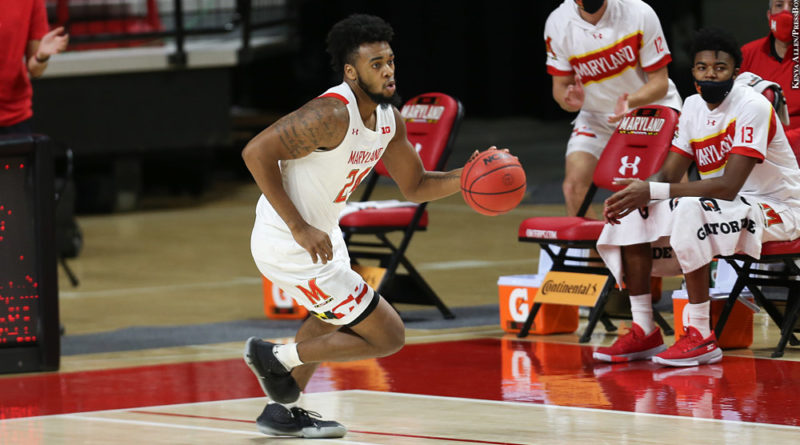If Maryland men’s basketball was still flying high after an upset victory at Illinois and an easy thrashing of Division II Wingate, the Terps crashed back to earth Jan. 19, falling 87-63 at the hands of No. 7 Michigan on the road.
The Terps (8-7, 2-6 Big Ten) were simply never in this game. Michigan, eager to bounce back from its first loss of the season last week at Minnesota, jumped out to a 17-3 lead in a little more than five minutes. The Wolverines (12-1, 7-1) led 42-25 at halftime and upped the margin to as many as 25 points as they cruised to the finish.
Isaiah Livers led the Wolverines with 20 points and shot 5-of-8 from the field, 4-of-5 from 3-point range and 6-of-6 from the free-throw line. Mike Smith scored nine of his 11 points in the first four minutes, while Franz Wagner chipped in 15 and Brandon Johns Jr. added 11. Michigan’s offense was sizzling all night and knocked down 51.8 percent of its field goals and 50 percent of its threes by the final buzzer.
Maryland’s offense couldn’t shake off a slow start, as the team shot 41.2 percent from the field and 21.1 percent from distance, in addition to a lackluster 56.7 percent at the line. Four Terps finished in double figures — Donta Scott 13, Eric Ayala 12, Aaron Wiggins 11, Jairus Hamilton 10 — but all four eclipsed that threshold with the game already well out of reach.
Losing to a top-10 team on the road isn’t particularly damaging to Maryland’s big-picture postseason hopes by itself, but the noncompetitive nature of this game won’t boost anyone’s confidence in the Terps. The Big Ten gauntlet continues Saturday, Jan. 23, at No. 17 Minnesota, then Jan. 30 against No. 10 Wisconsin at home — meaning Maryland will need to pull off another ranked upset to avoid falling to 2-8 in conference play. At some point, even with the schedule softening up in February, the hole might be too deep to climb out of.
Here’s what stood out from Ann Arbor, Mich.
1. Michigan’s offense dominated Maryland in a different way.
In the first meeting between these teams on Dec. 31, the Wolverines won the game in the low post, racking up 42 points in the paint and 18 more at the foul line (on 20 attempts). The star was freshman center Hunter Dickinson, who knocked down 10 of his 11 attempts en route to 26 points and 10 rebounds. That more than made up for an off night on the perimeter; Michigan shot 6-of-19 on threes and 24-of-32 on twos.
On this night, Dickinson tallied just three points and six rebounds on 1-of-3 shooting, and the Wolverines only led 30-24 in paint points. It was Michigan’s 3-point shooting that made the difference — 12-of-24 for the game and 8-of-14 in the first half, including a 5-of-5 start to open up the early lead. Smith hit three triples in the opening minutes to give Michigan an 11-3 lead, and Livers finished with four long balls on five attempts.
In a league many believe could send 10 or 11 teams to the NCAA Tournament (Maryland’s still in that mix for now), Michigan has set itself apart with this versatility. The Wolverines’ 3-point shooting has been inconsistent, but their overall field-goal accuracy has only dipped below 44.4 percent once all season. That came in their Jan. 16 loss at Minnesota, and this performance was a bounce-back and then some.
2. The Terps struggled with a locked-in Wolverines defense.
Michigan has length and quickness all over the floor, and while Maryland managed to move the ball well and generate quality looks Dec. 31, the Wolverines never really allowed that in this one.
With 14:16 remaining in the first half, the Terps were 1-of-5 with four turnovers and trailed 17-3. They never gave themselves a chance at a comeback, connecting on just 9 of 24 field goals and 2 of 10 triples in the opening period. Maryland’s 12-of-27 second-half clip was a slight improvement, but the Terps still shot just 2-of-9 from long range, bringing them to 4-of-19 for the game — a 21.1 percent clip, their third-worst of the season.
It seemed like every three was contested, every layup was in traffic and every pass had a defender ready to intercept it. And as has been a constant theme all winter, the Terps didn’t have an ace to lead them out of the hole they dug. Scott, Ayala, Wiggins and Darryl Morsell all attempted between eight and nine shots; only Ayala (5-of-10) cracked 50 percent, and the quartet combined to shoot 2-of-12 from deep.
3. Maryland lost key chances at the foul line.
The Terps shot 17-of-30 on free throws in the game, and while 20 of those attempts came with the outcome already apparent in the second half, 13 misses is simply unacceptable at this level. This was an issue all night — Maryland shot just 5-of-10 at the line in the first half, with the two most notable misses coming in a sequence that might just have been the early dagger.
With 52 seconds left in the period and Michigan leading 39-25, Hakim Hart was fouled on the floor and went to the stripe for a one-and-one. He missed the front end, Michigan pulled down the rebound and the Terps came up empty. Wiggins found himself in the same spot with 23 seconds left in the frame, and his shot rimmed out as well. Michigan’s Franz Wagner drained a corner triple just before the buzzer, and what could have been a 10-point margin was suddenly 17 at the break.
Maybe this game plays out differently if the Terps hit those shots and take some momentum into the locker room. Instead, the entire second half felt like a formality. It’s a disheartening loss and a reminder of the uphill battle ahead.
Photo Credit: Kenya Allen/PressBox

